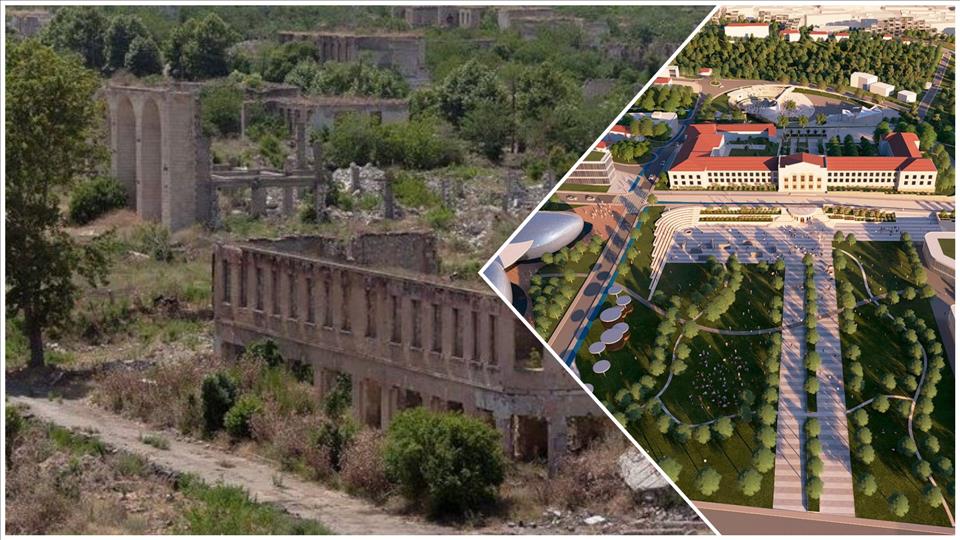
Reviving Liberated Territories: Azerbaijan's Vision For Garabagh
Since regaining control over Garabagh, Azerbaijan has transformed the landscape from war-torn to flourishing. Between 2020 and 2023, the state allocated $7.1 billion for the restoration of these regions, focusing on housing, infrastructure, and sustainable energy. Garabagh, once heavily impacted by conflict, is now a symbol of resilience, with newly established roads, modern infrastructure, and residential areas that have started to bring life back to the region. Thousands of homes, shops and historical and religious centers were destroyed by Armenian forces after they occupied the city in the 1990s and caused billions of dollars' worth of damage to the civilian infrastructure.
The country has unveiled ambitious plans for a multi-billion-dollar investment in Garabagh and East Zangazur, regions liberated in the recent conflict, to catalyze economic growth and infrastructural revitalization. Over the next several years, from 2025 to 2028, the government will channel an estimated $8.6 billion into these areas through state-funded projects aimed at transforming the liberated territories into thriving, self-sustaining communities. This initiative aligns with Azerbaijan's "Great Return" program, aimed at restoring life to these regions and providing long-term economic opportunities for local residents.
In 2024 alone, Azerbaijan has planned a substantial $2.8 billion investment under the First State Program of the Great Return. This allocation signifies the government's continued dedication to restoring Garabagh and East Zangazur, even after the $7.1 billion already invested from 2020 to 2023. These funds have been directed toward crucial infrastructure such as roads, utilities, and public services to make these areas more livable and economically viable for returning citizens.
Supporting agricultural revival through preferential leasing
A crucial component of Azerbaijan's plans for Garabagh and East Zangazur is the revival of the agricultural sector, which has deep historical and cultural significance in these regions. According to a recent draft law passed by the Azerbaijani Parliament, agricultural lands close to residential areas within villages and settlements will be leased to local residents on preferential terms. This leasing program, managed by relevant executive authorities, is designed to empower local farmers to cultivate both annual and perennial crops. Not only will this effort boost food production and reduce dependency on imported goods, but it will also offer economic stability and employment to residents in these areas.
This initiative stands as a testament to Azerbaijan's commitment to using the nation's agricultural potential as a foundation for sustainable economic growth. By making land accessible to local residents, the government is fostering community involvement in the region's development while also reinforcing food security and sustainable farming practices in a climate-sensitive world.
Long-Term Vision and Socioeconomic Benefits
The scale of the investment reflects Azerbaijan's long-term vision for these liberated territories as vital hubs within the country's economy. Through the Great Return program, these regions are being prepared not only for returning citizens but also for future generations.
By investing in critical infrastructure-such as roads, schools, healthcare facilities, and energy resources-the government aims to create an environment that encourages population resettlement and socio-economic stability. Moreover, the preferential leasing of land to locals symbolizes a broader commitment to empowering communities, encouraging local entrepreneurship, and enhancing food production capabilities in these regions.
Economic Impact Beyond 2028
The anticipated $8.6 billion investment over four years is expected to have a ripple effect on Azerbaijan's broader economy. Infrastructure development in these territories could create new markets, reduce unemployment rates, and raise living standards, ultimately integrating Garabagh and East Zangazur into the national economy. In addition, by fostering agricultural development, Azerbaijan is diversifying its economic base away from oil dependency, a key priority as the country transitions to a more balanced economy focused on sustainability. Azerbaijan's extensive restoration and development plan signals a bold new era for Garabagh and East Zangazur, positioning these territories as significant contributors to the country's economic and social landscape. With each phase of this investment, the government is laying the groundwork for a self-sustaining, resilient community infrastructure, securing a bright future for both the regions' residents and the country as a whole.
Legal Disclaimer:
MENAFN provides the
information “as is” without warranty of any kind. We do not accept
any responsibility or liability for the accuracy, content, images,
videos, licenses, completeness, legality, or reliability of the information
contained in this article. If you have any complaints or copyright
issues related to this article, kindly contact the provider above.























Comments
No comment